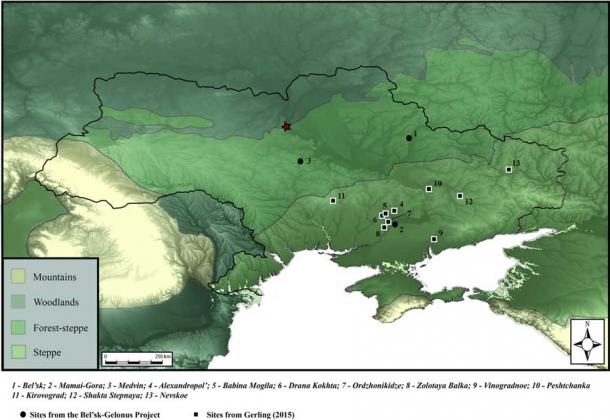The diets of ancient steppe Scythians, classically known as nomads, has revealed that while some of the population did indeed travel far and wide warring for new lands on horseback, many didn’t, and most settled where they were born.
Most Scythians Preferred Farms and Fires Over Swords
Scythians emerged from the Pontic steppe (southern Siberia) around 700 to 200 BC and dominated all territories between the Black Sea and China. In the 5th century BC, Greek historian Herodotus wrote that the Scythians descended from the child of Heracles and a hybrid snake-woman. Since then they have been perceived as nomadic horse-riding warriors. Now, a new paper by Professor Alicia R. Vetresca Miller of the University of Michigan, published in the journal PLOS ONE , suggests that Scythian people led more complex and settled lives than is commonly assumed.
The new study set out to reveal secrets pertaining to the “diet and mobility” of Scythian populations. This lead the team of researchers to undertake complex isotopic analysis of carbon, nitrogen, oxygen, and strontium from human teeth and bones recovered from Scythian burial sites in Ukraine. The results of the study directly challenge the commonly held stereotype that the Scythians were horse-riding long-distance nomadic warriors , claiming that most “did not travel long distances during their lifetimes.”

Map showing location of Scythian remains in Ukraine and surrounding areas under analysis in this study. (Miller et. al / PLOS ONE )
Breaking with False Historical Narratives
As with so many aspects of life, when the facts of any given scenario or situation are laid out in the clear light of day they often challenge our general perceptions of that thing. This is made evident in the rom-com movie industry which portraits Christmas in the U.S.A like some international fiasco where the entire nation is loaded into airports trying to get “home” for the big day. Well, that’s all just a load of guff according to a 2015 New York Times article entitled The Typical American Lives Only 18 Miles From Mom that explains how the vast majority of Americans don’t live further than 20 miles from their parents homes.
This is exactly the case for ancient Scythian populations. While it was believed ipso facto that Scythians were a greatly nomadic warrior culture, after a little bit of digging it’s become clear that Scythians were a much more culturally diverse group. The new paper explains that in most cases Scythians led “sedentary lives with a dependence on agriculture.”
The authors of the study say their new findings will help archaeologists formulate a more complete idea of Scythian history now that it is known most people “did not” travel long distances. Furthermore, the researchers demonstrate in the new paper how dietary items prove that the majority “remained local to their settlements, farming millet and raising livestock in mixed economic systems.”

Up until now, academia has held on to the stereotype that Scythians were nomadic warriors. This new study turns that belief on its head. ( Public domain )
Challenging the Classic Nomadic Warrior
Based on teeth and bone remains at Scythian burial sites, this new finding is not like Mike Tyson being caught in a pink dress. The fact that a culture who were traditionally interpreted as “warriors” should more accurately be described as farmers, doesn’t mean they were any less fierce. They were a hard people. Don’t for a second think that the agricultural lifestyle was any less challenging than the fighting culture in the ancient world. Working every day and night, often without rest for weeks at a time, Scythian farmers fought enemies on several fronts.
Rival clans would attack each others farmsteads at night, while the effects of flash floods took constant back-breaking work to overcome. Keep in mind that, as anyone out there with green fingers knows, extremely wet conditions are fertile breeding grounds for the diabolical Botrytis cinerea . This necrotrophic fungus affects many plant species and it is most commonly known as grey mold. One patch of this microbial killer left unseen could destroy an entire field system in less than a week, leaving families huddled together in crofts starving, dying one by one, wishing they has chosen the way of the sword and not the hoe.
Top image: New study analyses the ancient diet of Scythians using their human remains, to conclude that in actual fact most Scythians lived a sedentary agricultural lifestyle. Source: nidvoray / Adobe Stock
By Ashley Cowie
 RSS Feed
RSS Feed















 March 12th, 2021
March 12th, 2021  Awake Goy
Awake Goy  Posted in
Posted in  Tags:
Tags: 













